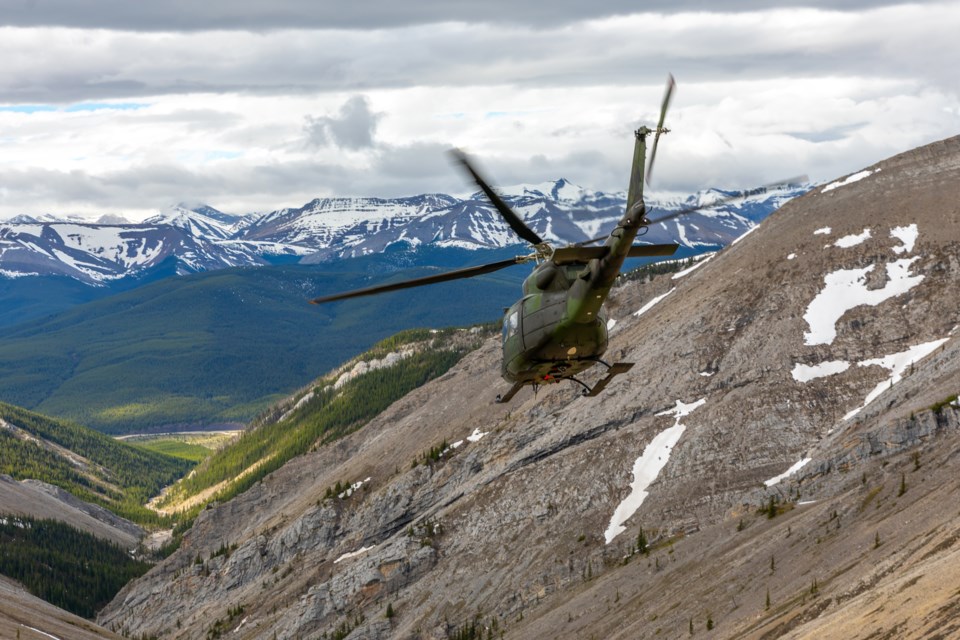SUNDRE — A Royal Canadian Air Force helicopter squadron has recently been conducting mountainous terrain training in tandem with ground crew in the Ram Falls region.
About 20 members of the 408 Tactical Helicopter Squadron (THS), coordinating with two military-patterned vehicles travelling by road, honed their domestic roles of responding to emergencies such as floods and wildfires, said Major Rodney Dietzmann,
The exercise, which stretched from Ram Falls to Nordegg, Rocky Mountain House, Sundre, and even B.C., was carried out July 9-11 using three CH-146 Griffon helicopters. It followed up on the heels of recent training in the same region in June, with additional plans to return later this month as well as in August, said Dietzmann.
“It’s a new one this year for us,” he said, when asked whether such exercises had been done in the area before.
“It’s an opportunity for us to train for domestic support in mountainous regions,” he elaborated.
A Canadian Armed Forces press release said no firearms were involved in the training.
“It’s more for wildfires and floods — that would be our main role, domestically,” Dietzmann said about the exercises. While the squadron has been deployed overseas, at home, the unit typically is called upon to provide assistance during natural disasters, he added.
“It’s good to take pilots up and keep them fresh, and train new ones that have never operated in mountainous terrain.”
Based out of Canadian Forces Base Edmonton, 408 THS has the principal role of supporting units of 1 Canadian Mechanized Brigade Group as well as Joint Task Force (West), the release states.
Responsible for responding throughout the Prairies, a portion of northwest Ontario, and most of Canada’s north except for the Yukon, Dietzmann said the squadron strives to ensure crews are always ready to fly in all sorts of different conditions, including of course, the Rockies.
“Obviously being based in Edmonton, there’s not a lot of mountains right here,” he said, adding main training exercises are usually held at Canadian Forces Base Wainwright, which also lacks mountainous terrain.
“There’s different weather conditions, what you can expect — winds, definitely the altitude has an affect on how the helicopter performs (in the mountains),” he said.
There’s more involved, however, than an exclusive focus on flying, he said.
“We have a couple of vehicles along — we take advantage while we’re flying down and back to do some overhead escort. Part of our training is we over watch road moves from above. We try to get as many checks in the boxes as we can.”
And this year, the pandemic has introduced some new planning and logistical considerations, he said.
“We always take safety seriously. But the added one this year is, of course, operating in a COVID-19 environment, which brings a whole bunch of different factors into play.”
For example, Canada’s armed forces have been ordered and mandated to maintain a minimum physical distancing of two metres and to wear masks in situations when that’s not possible, he said.
“Staying safe and healthy is job No.1. Otherwise, we’re unable to help anybody.”
Arrangements with the provincial government must also be lined up in advance, and Dietzmann said a land user agreement is required to ensure, among other aspects, that environmental safety factors for the base are factored in to plans.
“The province was happy with the presentation and all matters of safety — whether it’s flight safety, environmental safety, COVID-19 safety this year — (which) are paramount of course in the planning process, and they’re all included in this exercise,” he said.
Operating under the banner of the Canadian Armed Forces, the Royal Canadian Air Force coordinates training with ground personnel who provide logistical support including any necessary field repairs and meals, he said.
“It’s a chance for them to come out as well and be able to set up. If we need to fly a little bit farther away, we can’t always return back to Edmonton, so it’s good to have ground support, and the personnel and the equipment there.”
The CH-146 Griffon helicopters can carry four crew, he said.
“Two pilots, one flight engineer, and — we don’t use them domestically other than for an extra set of eyes — but we do have a fourth member that can be on there, and that is a door gunner. That’s obviously more for when we go overseas, but they do provide a very good set of eyes on the other side of the helicopter and are able to assist in a lot of other ground work.”
Gunners, who are members of the armed forces, bring with them a different set of ground skills and are trained to see and understand things differently from a ground perspective, he said.




